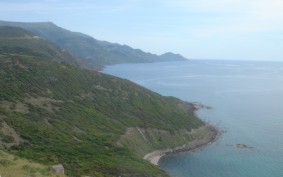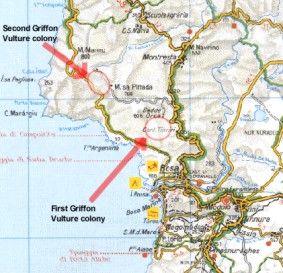| Back to Homepage |  |
|
The only 2 remaining Griffon Vulture colonies in Sardinia are located along the coastal road north of the town of Bosa on the west coast of Sardinia between Oristano and Alghero. This stretch of coastline is relatively untouched by tourism and provides excellent habitat for a range of species. The valley of the river Temo, which runs into the Mediterranean at Bosa also provides excellent habitat for birdwatching, with extensive holm oak forests and rough grazing pasture for livestock. The largest of the two Griffon Vulture colonies is just a few kilometres north of Bosa (see map). The coastal road (signposted: Alghero) heads north from the road linking Bosa with Bosa Marina. After a kilometre or two it turns west towards the sea. The first colony can be seen in the distance from the road just after it turns west. Just opposite a small restaurant on the right, called "Il Griffone" (a good clue!), there is a lay-by on the left where you can pull over and park. Look to the north, and you will see a steep cliff. This is where the first colony is located. Throughout the summer at most times of the day there should be several Griffon Vultures circling above the colony. There is more activity later on in the day, especially in the late summer, when the young birds are learning to fly. In the winter the birds are still there, but less active, so they're more difficult to see. The second colony, although smaller, is much closer to the road, about another 5-6 kilometres further north on Monte sa Pittada. The road turns further inland and climbs steeply from the coast. Several rocky outcrops can be seen above the road. Look for the tell-tale signs of white droppings staining the rocks to locate the nest and roosting sites. More patience is required to see the vultures on the wing here, as there are fewer of them and the nests are more dispersed, but it's worth it as some of the birds soar right above the road. PLEASE NOTE: Griffon Vultures are very sensitive to disturbance. Do not leave the main road to get closer to nest sites. Do not disturb any birds on the nest. Human disturbance is the main cause of breeding failure for Sardinia's Griffon Vultures. Thanks to the project Entulzu Bosa (Entulzu means Griffon Vulture in the local Sardinian language), this tiny remnant population of Griffon Vultures has been protected and bolstered by the introduction of birds from Spain and France (same subspecies: Gyps fulvus fulvus). Legambiente Sardegna perform constant surveillance of the nesting sites all year round, and recently land at Capo Marrargiu has been acquired as a reserve for the species. However, the use of poison on animal carcasses to kill foxes and stray dogs is still common (albeit illegal) in Sardinia, so the birds are in constant danger of extinction. Most years less than 30 pairs breed. The total population was estimated at under 100 birds in 2006. For more information, you can contact the Entulzu Bosa information centre: 348 0012988. If you see any trespassing near nest sites, please contact the Corpo Forestale: 0785 373747. The coastal road to Alghero continues north, clinging to the side of the hills and offering spectacular views. The landscape is remote with few other roads and little human presence. There are miles of excellent macchia scrub along this road, as well as small tracts of holm oak forest in some of the valleys, which for most of the year have freshwater streams which encourage insects and therefore more bird species. There are plenty of lay-bys for parking and there is an Alghero - Bosa bus which stops at a few points along the way (if you ask the driver nicely, he'll usually let you off anywhere!). As well as the Griffon Vultures, this stretch of coast is good for a variety of raptors, including Golden Eagle, Lesser Kestrel, Kestrel, Buzzard, Peregrine Falcon, Montagu's Harrier (in the summer - south of Bosa) and Red Kite. Red Kites are rare in Sardinia and are known only to breed in the river Temo catchment area, from Bosa to Pozzomaggiore. Some birds are also present in the area in winter. Other species I've recorded in the area include Bee-eater, Blue Rock Thrush, Raven, Cirl Bunting, Stonechat, Sardinian Warbler, Zitting Cisticola, Cetti's Warbler and Nightingale (these 3 species near running water), Alpine Swift, Pallid Swift, Red-rumped Swallow (on passage), Crag Martin, Turtle Dove (summer), Red-backed Shrike (summer), Spotted Flycatcher, Jay, Wheatear, Corn Bunting and Barbary Partridge. The valley of the river Temo is very good for finches, including Serin and Hawfinch, as well as Cattle Egret and Spotless Starling all year round. Dartford Warbler are fairly common in suitable habitat further up the valley. |
Looking south along the Alghero Bosa road
Map showing the location of the two Griffon Vulture colonies. Click on the map for a larger image. |

